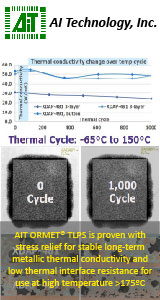|

|
|
| Ask the Experts | |||||||
|
|||||||
|
July 30, 2007 - Updated July 29, 2007 - Originally Posted Wire stripping insulation prior to tinningWhen using spring loaded wire strippers, is it the best practice to strip insulation and leave it on the end of the wire until it is ready for tinning? Thanks for your assistance. P.M. |
|||||||
| Expert Panel Responses | |||||||
|
This is a good idea. Leaving the stripped end on the wire protects it from damage as it is moved around your facility.
Regional Sales Manager OK International Inc. Ed Zamborsky is a Regional Sales & Technical Support Manager for Thermaltronics, located in New York. His position requires frequent customer visits throughout North America and the Caribbean and his position encompasses not only sales but the role of trainer and master applications engineer for all of Thermaltronics products. His expertise includes such specialties as hand soldering, convection and conduction reflow techniques, array rework, fluid dispensing equipment, and fume extraction. Ed has authored many articles and has presented many papers on topics such as; Low Volume SMT Assembly, Solder Fume Extraction, SMT Rework, BGA Rework, Lead-Free Hand Soldering, High Thermal Demand Hand Soldering, Lead Free Visual Inspection and Lead Free Array Rework.
If the wire being stripped is multi strand - Yes. It will keep the wire structured prior to tinning and stop it fraying.
CEO ATEK llc Allen Duck is a 20-year Electronics Industry veteran with Global experience in multiple fields of technology and management. He started A-Tek in 2006 to provide a sales and service channel for international equipment companies wishing to offer value based solutions to USA companies.
This is all dependent upon the manufacturing cycle and the time span between the stripping operation and either the tinning or lugging operation. Leaving the insulation on the wire only protects the wire stray splay from being disturbed, which could cause birdcadging and similar types of problems. Leaving it on also creates another operation when the wire is to be either tinned or lugged, so that should be factored in the decision.
Vice President, Technical Director EPTAC Corporation At EPTAC Corporation, Mr. Lambert oversees content of course offerings, IPC Certification programs and provides customers with expert consultation in electronics manufacturing, including RoHS/WEEE and lead free issues. Leo is also the IPC General Chairman for the Assembly/Joining Process Committee.
|
|||||||
| Submit A Comment | |||||||
|
Comments are reviewed prior to posting. You must include your full name to have your comments posted. We will not post your email address. |
|
Free Newsletter Subscription
Circuitnet is built for professionals who bear the responsibility of looking ahead, imagining the future, and preparing for it. Insert Your Email Address |
|

|





